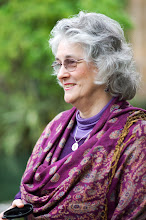 |
| Witch Riding Backwards on a Goat |
November 2014
San Diego, CA
Day Two:
Saturday Morning
Saturday morning I passed
on the “Plenary Panel: Release of
PRRI/AAR National Survey on Religion, Values, and Climate Change,” because,
although I’m interested to see how mainstream religions are now paying closer
heed to our utter and complete interdependence upon other species, weather, and
other planetary phenomena, and am encouraged, I decided to pass.
Instead, I attended the
Arts, Literature, and Religion Section on “Writers
and Artists as Agents of Cultural Change”
“What roles, if any, do writers and artists play in processes of
cultural change, and what roles does religion play in an artist’s cultural
agency? Does individual interpretive and
imaginative work influence culture or merely reflect it?”
As one of the panelists
said at the outset of this series, “We rarely know what we’re doing until
someone else tells us.” That is one of
the roles of artists and writers as interpreters of culture as well as in their
roles as agents of change – to show and tell us what our behaviors seem to be
indicting.
Discussions and analyses
have traditionally taken place in pubs and coffee houses. One panelist claimed that it is in these
venues where ideas are transmitted, which may account, at least in part, for my
affinities for metropolitan life. It
offers more access to other minds and other perspectives. With the exception of Emily Dickinson, all
the subjects treated were social creatures, very much engaged in the society
around them.
According to the
presider, Shakespeare invented the idea
of human personalities as agents for social and cultural change.
Each of four panelists
spoke about an individual whose life works served these functions: painter and engraver Albrecht
Dürer, poets Emily Dickinson and Allan Ginsburg, and musician and songwriter Bob Dylan.
First, and by far the
most interesting to me, was Dürer, primarily because I knew so little about
him. One of the panelists remarked that
she learned more about Dürer in this presentation than she’d ever known before. I did, too.
In today’s digital world, few but art historians delve into the works of
German Renaissance artists.
.jpg) |
| The Fall of Man |
 |
| Expulsion from Paradise |
Among the other interesting characteristics of Dürer’s art is that he embraced the new technology of etching. This presages new digital technologies in contemporary art. He also inserted himself and his friends into his etchings. Although this was not a fact mentioned by the presenter, I have since found that Dürer created many images of Pagan personages such as Nemesis, Apollo, Diana, and Orpheus, and allegorical figures such as Melancholia and Death, as well as the zodiac.
.jpg) |
| Idealistic Male and Female Figures (Adam and Eve) |
Bob Dylan, who was Zen, Christian, and Jew, all advanced
and exclusive of each other.. Is he
“unknowable” religiously? His
evangelical turn/”conversion” occurred in the 1970s, during the Presidency of Jimmy
Carter, and the rise of the Moral Majority.
Dylan was introduced to the born-again creed of a charismatic sect
called the Vineyard Christian
Fellowship in 1979 when he became friends with
Kenn Gullicksen, one of its founders.
My experience with
Vineyard Christian Fellowship locally is minimal, except that I’ve noticed they
keep a tight focus on their own version of Christianity and conversion, with
little involvement in wider community issues.
Regardless of his enigmatic religio-spiritual identity, there is no
doubt that Bob Dylan’s artistic output has influenced contemporary society.
Allen
Ginsberg, such a mensch! From his time at Columbia University in the
late 1940s, through the publication of “Howl” in the ‘50s, and up until the
time of his death in 1997, Ginsberg encouraged new literary and cultural,
political, sexual, and religious expression.
A Jew by birth, Ginsberg was one of the founders of the Beat Generation
in San Francisco in the ‘50s, traveled to India in 1962, where he studied yoga
and meditation, and later embraced Buddhism.
He is tied to Eastern religions and the counter culture, and he lived
where the culture around him enabled his ideas to be heard.
The respondent to these
presentations asked two questions: Is it
the religion around or the cultural icon that predominates? Is the artist a reflection or an agent of
cultural change? I would answer
“both/and.”
* * * * *
More to come.

No comments:
Post a Comment